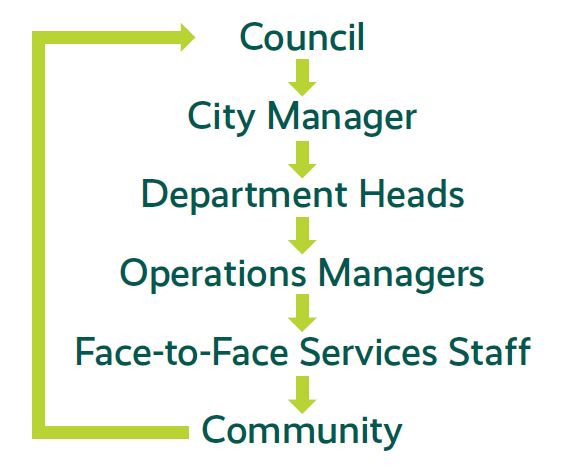
For an enhanced digital experience, read this story in the ezine.
The “textbook” model of local government suggests the fair (equitable) way to allocate park and recreation services is: (1) to embrace the interpretation articulated by a majority of residents; who (2) influence their elected representatives; who (3) direct administrators to make decision-rules that implement policy; that (4) agency personnel follow in order to carry out policy. The diagram below illustrates this premise.

This process is not followed in many communities in the context of equity, where the reality is that inertia prevails. Historical and cultural routines are challenged and perceived to be unfair only when a group of residents believe it is their “ox that is being gored.”
In the past, residents’ input in deciding how equity should be interpreted has not been solicited because the need to explicitly address the different interpretations of equity, the nuances of its interpretations, and a lack of consciousness of its pervasive influence in service delivery decisions have not been recognized by park and recreation directors and managers as a relevant concern. However, this is changing with the advent of social media, increases in the numbers of activist groups, and a reaffirmation that the essence of marketing is a commitment that park and recreation services be resident driven.
Responsible Parties
The prevailing patterns of park and recreation services will be the result of actions from three sets of actors: elected officials, park and recreation administrators and front-line staff.
Elected Officials – The policy role of elected officials is primarily enacted through their budgetary decisions. Equity is strongly influenced by the amount of funding allocated to specific services. It is likely to impact the types and locations of services or facilities offered, and their capacity, scope and range. Their impact on equity is likely to be particularly dominant in decisions relating to large capital-intensive projects.
Administrators – Typically, elected officials define generic needs in a community and then ask staff to allocate services to meet those needs. This cedes considerable discretion to the city manager and park and recreation administrators. The discretion may reflect residents’ recognition that park and recreation managers are committed public servants striving to achieve the public good who possess the professional competence to do it well.
The discretion is exercised through the decision rules they formulate in response to, or in the absence of, policy directives provided primarily through the budget.
Front-Line Staff – Many decision rules are viewed by managers as guidelines, recognizing that they must be written to embrace a wide range of contingencies. This means that front-line staff who interact directly with participants may be the policymakers in their respective work areas because they have discretion in interpreting the decision rules.
A consensus on the interpretation of equity among these three groups and on the decision rules and procedures used to operationalize the agreed interpretation is essential. Without it, the allocation pattern of resources is unlikely to be coherent. However, achieving the required degree of commitment to a given policy is a difficult task. Equity reflects values, which are deeply felt. These are residual in the sense that staff bring them to the job. The only way to establish congruency among the various actors in a city’s delivery system is to hire people whose values are consonant with, or at least tolerant of, the majority of residents and city council members from the outset.
A colleague and I surveyed a probability sample of 833 Texans and asked questions designed to ascertain which interpretation of equity they most supported for allocating park and recreation funds in their communities. Three-
quarters of them opted for allocating resources equally across all areas. A similar response was forthcoming when the same series of questions were posed to 64 Texas city park and recreation directors.
In our discussion, we suggested residents’ responses perhaps reflected America’s traditional egalitarian ethos, while the directors’ responses may have reflected a desire for a noncontroversial stance that is the safest path through the political minefield of equity options. Certainly, the consensus among citizens for this option provides directors with justification for their pragmatic response, because it is consistent with that of their constituents.
However, it is possible many respondents did not realize that equality of inputs is not a commitment to egalitarianism (i.e., fairness) if the existing facilities, services and equipment that those inputs are intended to sustain historically have been inequitably allocated. This is a complex idea to communicate and the probability of a lack of understanding illustrates the challenge of agreeing upon an interpretation of equity.
However, the starting point for developing an equity roadmap is to explicitly recognize different interpretations of equity, their different operationalizations and their different measures. A few years ago, a colleague, Stephanie West, and I developed an instrument and established its validity and reliability to measure citizens’ equity preferences among the various interpretations of equity. In an ideal world, this would form the basis for an equity roadmap.
John L. Crompton, Ph.D., is a University Distinguished Professor, Regents Professor and Presidential Professor for Teaching Excellence in the Department of Recreation, Park and Tourism Sciences at Texas A&M University and an elected Councilmember for the City of College Station.

